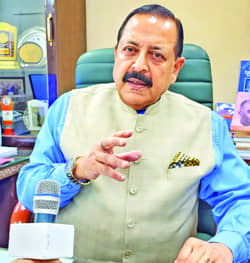Chandrayaan to send information about Moon’s atmosphere, soil, minerals etc: Dr Jitendra

STATE TIMES NEWS
NEW DELHI: Chandrayaan-3 mission is expected to send home information about Moon’s atmosphere, soil, minerals etc which may be the first of its kind for the scientific community across the world and of far-reaching implications in the times to come, said Union Minister of State for Space, Dr. Jitendra Singh on Sunday, adding that the Vikram Lander and Pragyan Rover have started performing the Mission objectives exactly as per the schedule.
In an exclusive interview to a media agency, Dr Jitendra said, the main focus of the science payloads onboard Chandrayaan-3 is to provide an integrated assessment of the lunar surface features, including the thermal properties and surface elements of the lunar topsoil (regolith) as well as the plasma environment near the surface, he said. It will also assess the lunar seismic activities and the impact of meteors on the lunar surface. “All these are essential for the fundamental understanding of the lunar near-surface environment and for making future lunar habitat developments for explorations,” said Dr Jitendra Singh.
Vikram Lander carries seismometer (ILSA), ChaSTE, Langmuir Probe (RAMBHA-LP), and a laser retroreflector array payloads and the Pragyan Rover carries Alpha Particle X-ray Spectrometer (APXS) and Laser Induced Breakdown Spectroscope (LIBS) payloads.
“All these payloads are planned for continuous operations from 24th August 2023 till end of the mission,” said Dr Jitendra. The Instrument for Lunar Seismic Activity (ILSA) will make continuous observations of the lunar seismic activities as well as the meteors impacting the lunar surface. ILSA is the first-ever seismometer sent to study the vibrations on the lunar surface at higher lunar latitudes. “These measurements will help us plan for future habitat developments by understanding the frequency of potential hazards from meteor impacts and seismic activities,” said Dr Jitendra.
The ChaSTE (Chandra’s Surface Thermo-physical Experiment) is another key instrument mounted on the Vikram Lander, said Dr Jitendra Singh. Ten high-precision Thermal Sensors, mounted on ChaSTE, will dig into the moon’s top soil to study temperature variations. ChaSTE is the first-ever experiment to study the thermophysical properties of the first 10 cm of the lunar surface. Surface of the moon undergoes substantial temperature variations during the lunar day and night, with minimum temperatures of <-100 ? around the local midnight, and >100? around the local noon. The porous lunar topsoil (having a thickness of about ~5-20 m) is expected to be an excellent insulator. Because of this insulating property and absence of air, very significant temperature difference is expected between the top surface and interior of the regolith. “The low density and high thermal insulation of the regolith enhances its potential as a basic building block for future habitats while the assessment of the wide range of temperature variations are crucial for survivability,” said Dr Jitendra. The study of the near-surface plasma of the Moon and its time variations will be carried out by the Langmuir probe. RAMBHA-LP will be the first-ever in-situ observation of the near-surface plasma and its diurnal variation in higher lunar latitude, where the Sun elevation angle is less, said Dr Jitendra.
“These will help assess the lunar surface charging for future manned missions,” he said.
The Alpha Particle X-ray Spectrometer (APXS) and Laser Induced Breakdown Spectroscopy (LIBS), mounted on the Pragyan, will make the measurements of lunar surface elements at the stop-points (once in about 4.5 hours) along the Rover track. These are first-ever in situ study of lunar surface elemental composition in the higher latitudes, said Dr Jitendra. “These measurements can make inference on the potential surface elemental compositions which will be helpful for future self-sustaining habitat developments,” he said. Besides probe instruments mounted on the Lander & Rover, the Chandrayaan-3 Mission carries the Spectropolarimetry of Habitable Planet Earth (SHAPE) onboard the Propulsion orbit of the moon.
“It will help identify earth-like exoplanets in future,” said Dr Jitendra Singh, adding, “The data will be made available to the students and general public after the initial analysis and consolidations.
Dr Jitendra Singh said that in the past nine years after the Prime Minister Shri Narendra Modi assumed office, been given the freedom to apply space technology to areas of infrastructure development. Dr Jitendra Singh said the ISRO will launch an awareness campaign across the country next month, mobilizing students and the common man in view of the huge interest witnessed in the Live telecast of Chandrayaan-3 Moon Landing.
